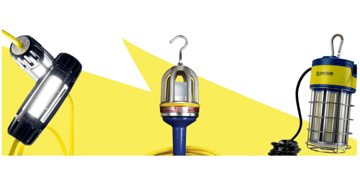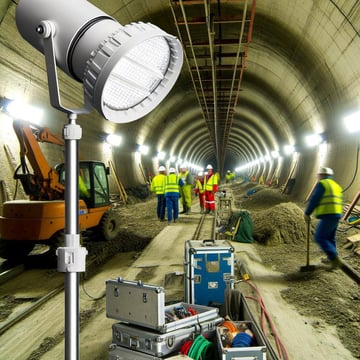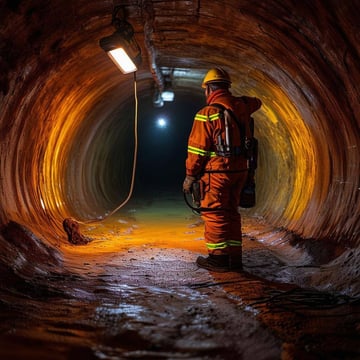When it comes to lighting for industrial, construction, or jobsite environments, there’s more to think about than just fixture type or wattage. When it comes to performance and safety, there’s one metric that matters most: lumens.
In this blog, we’ll answer two of the most common questions around lumens in lighting:
- What are lumens?
- Why do they matter when it comes to lighting?
Read on to learn about how to evaluate lighting options with confidence while ensuring your workplace is safe, efficient, and code-compliant.
What Are Lumens?
Lumens are the unit of measurement that define the total visible light emitted by a single source. The higher a lumen rating, the greater the brightness, regardless of energy consumption. Unlike watts, which show power usage, lumens indicate the amount of light you’ll actually get.
There’s a big difference between the two, which is all the more important as LED lighting continues to outpace traditional bulbs. With LED lights, wattage doesn’t align with brightness. This means it’s vital to prioritize what the lumens are when evaluating fixtures.
The Role of Lumens in Industrial Settings
The lumens in lighting fixtures impact visibility, worker safety, and even regulatory compliance. That’s part of why it’s so important for jobsites and factor floors to be aware of OSHA and NEC guidelines. These guidelines often outline lumen output, which helps you stay compliant, safe, and effective.
Lumens vs. Watts: What’s the Difference?
Lumens and watts measure two very different things when it comes to lighting, and understanding the difference is key to choosing the right fixture. Watts indicate how much energy a light bulb consumes, while lumens measure the amount of light it actually produces. In the past, people used watts as a proxy for brightness, assuming a 100-watt bulb was brighter than a 60-watt one. With today’s energy-efficient LED technology, that’s no longer accurate. A 10-watt LED can emit more lumens than a 60-watt incandescent bulb, meaning it uses less power to produce the same (or even greater!) brightness. When selecting lighting, especially for demanding environments like jobsites, it's important to focus on lumens to ensure you're getting the visibility you need without wasting energy.
When choosing lighting, focus on the lumen output instead of the wattage. That way, you’ll get the illumination you need for your particular worksite.
How to Measure Lumens
The most common way to measure lumens in lighting is with foot-candles. Foot-candles are a unit of measurement used to determine illuminance, or how much light actually falls on a surface. Each foot-candle represents the light at a distance of one foot. Simply put, a foot-candle is the amount of light that illuminates a square foot of surface in relation to one lumen.
In order to determine the number of lumens you need for a space, you take the number of foot-candles and convert them into total lumen output. If OSHA requires 5 foot-candles in a 1,000 square-foot space, you’d need about 5,000 lumens.
Always check manufacturer specifications to confirm your lumen ratings and ensure accurate assessment.
Lighting Lumens by Application
Different types of worksites will require different lumen levels. What works in one environment may not work in another. General jobsites typically need between 2,000 and 5,000 lumens.
For delicate work like inspections or wiring, go with 3,000 to 7,000 lumens. Emergency exits, meanwhile, need 750 to 1,500 lumens to maintain visibility without glare. Finally, warehouses or high-bay areas may require over 20,000 lumens to maintain compliance.
How Ericson Delivers High-Lumen Value
Ericson specializes in industrial lighting solutions that provide maximum lumen output while cutting energy consumption. Our work lights have lumen ranges from 1,200 lumen string lights to explosion-proof fixtures capable of providing up to 10,000 lumens. Every Ericson product clearly states its lumen output, making it easy to meet OSHA and NEC requirements.
Shop Our High-Lumen Industrial Solutions
When it comes to reliable, high-performance lighting for every environment, Ericson delivers. Our rugged, high-lumen fixtures are engineered for industrial and outdoor use. Our products are OSHA-compliant and NRTL-certified, ensuring safety, efficiency, and productivity. Explore our full range of industrial lighting solutions, or contact our team to learn more.
Tag(s):
Brian Earl
Hailing from Minnesota originally, Brian began his secondary education at the University of Minnesota with his undergraduate work and his MBA in Management at University of Michigan, focusing on strategic marketing and market planning. He has an extensive background in developing and leading a variety of marketing,...
More from the blog
View All Posts
Certifications and Regulations
6 min read
| December 14, 2021
Safe & Compliant Jobsite Lighting
Read More
Workplace Safety
17 min read
| August 20, 2024
Industrial Grade Job site Lighting Solutions for Confined Spaces
Read More
Workplace Safety
11 min read
| September 26, 2024
Choosing the Best Lighting for Harsh and Hazardous Environments
Read MoreSubscribe to blog updates
Stay up-to-date on what's happening at this blog and get additional content about the benefits of subscribing.
